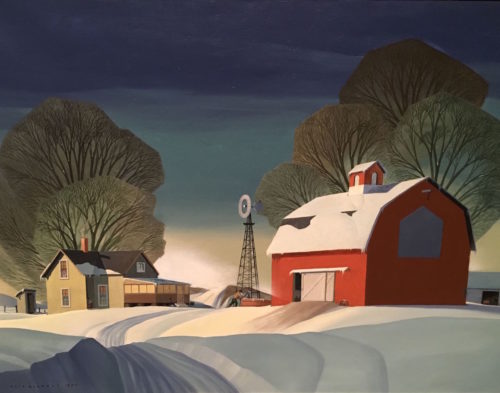KEARNEY — The artwork of Dale Nichols looks deceptively simple.
“They’re simple in their form but they’re not simple in the way they were composed,” Amanda Mobley Guenther, curator at the Bone Creek Museum of Agrarian Art in David City, said of the painting by the Nebraska-born artist. “I have examples in the book that I wrote about Nichols where he built a grid sketch for the composition. It helps form the composition, making sure that all of the elements were balanced and pleasing in that grid.”
Combined with the amount of planning, Guenther sees a tremendous amount of complexity in the artwork of Nichols, a man she calls a Nebraska regionalist.
“It’s not like he just started painting with no preliminary drawings and no preliminary sketches, that he just put brush to the canvas,” she said. “That would be simple.”
Guenther will present “Amanda Mobley Guenther: Dale Nichols, Nebraska Regionalist” at 2 p.m. Wednesday at the Museum of Nebraska Art in Kearney as part of the museum’s Collection Connection series. Admission to Guenther’s talk is free.
Bone Creek Museum of Agrarian Art features paintings by Nichols in its collection. An exhibit of his work, “Dale Nichols: Nebraska Regionalist,” continues on display through April 2 at the Museum of Nebraska Art in Kearney.
The artist, born in 1904, grew up in David City. He studied at the Chicago Academy of Fine Arts and worked as the art director for the Encyclopedia Britannica. He died in Sedona, Ariz., in 1995, at the age of 91.
Associates described Nichols as not an easy person to get along with.
“That’s the way the story goes,” Guenther said. “I never met him personally. I didn’t know Dale Nichols so I can’t say that from personal reference. However, I know people who knew him and I’ve read lots about him. From what they say, he was quite egotistical.”
Guenther wrote a book about Nichols, “Dale Nichols: Transcending Regionalism,” in 2011.
“Maybe he had more of that stereotypical artist personality that’s kind of hard to get along with,” she said. “I don’t think it matters when looking at his art. I guess people can read a meaning into that. I don’t think it matters.”
Even though Nichols possessed faults, Guenther points out that he was extremely social.
“The correspondence level he had with people across the country, regardless of where he lived in the country, was remarkable,” she said. “At that time it wasn’t by email and it wasn’t by text. It took a lot longer to type letters and draw little sketches. He had a great amount of correspondence with people — collectors and people interested in his work. His illustrated letters were charming. They were delightful.”
Guenther sees the work of Nichols as reflecting a sense of place and pride in Nebraska.
One of the artist’s strong points — he knew how to finish a painting.
“It takes a great skill of an artist to know when to quit, to not continue fussing with a painting,” Guenther said. “A great artist knows when to put the paint brush down and leave it. That takes tremendous skill and self control.”


